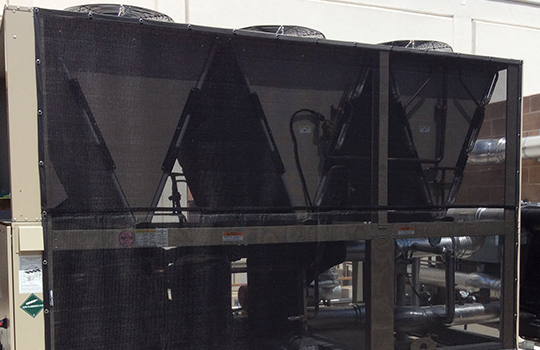Click on a question below to see the answers to some of the most frequently asked questions about cottonwood screens.
“What’s A Cottonwood Screen?” and Other Important Questions
Yes. Because cottonwood is such a significant problem in some areas, many people refer to the product as a “cottonwood screen” or a “cottonwood filter.” Because the screen fits over an air intake opening, they are also commonly referred to as an “air intake screen” or “air intake filter,” particularly in areas where cottonwood is not a significant problem.
Yes. Just a few cottonwood seedlings wouldn’t seem to do a lot. But each cottonwood tree can release more than 25 million seeds a year, and seeds can travel up to five miles away. So you can imagine what sort of trouble all that cottonwood can do to a rooftop HVAC unit. Of course, a cottonwood screen not only protects units from cottonwood but from all sorts of debris including leaves, dirt, seeds, insects, dust and pollen. They prolong equipment life, help you save considerable maintenance and cleaning costs, and reduce energy consumption (and utility bills). By making HVAC equipment work better and more efficiently, cottonwood filters also ensure cleaner air which can improve employee productivity and health, and keep computer equipment performing better and lasting longer.
It depends on the environment around you, and the time of year. For example, cottonwood trees can lose their seedlings from May through October. During the worst of the season, you may want to check the screen every week or two, although typically you can check it less often.
None. Since PreVent air intake screens can simply be brushed down, in place, you won’t need any downtime to clean them. You can also vacuum or clean them with a hose. If you clean them with a high-pressure hose make sure you remove the screens first, to avoid damaging the fins behind them.
Yes, but not as often. One of the main advantages of a cottonwood screen is keeping your coils clean, which lessens the need for frequent cleanings. Customers of our PreVent air intake filters typically save 25% or more in their coil cleaning costs alone.
Just make sure you install your cottonwood screens over a clean coil! Clean coils are important to ensure long and optimal HVAC equipment performance. According to EPA research, just 0.042″ of dirt on an air conditioning coil can reduce its efficiency by 21%. Dirty coils can increase energy and cleaning costs by more than $22,000 a year per unit!
Not only is polypropylene a hardy, sturdy material that can withstand the rigors of a rooftop environment, but polypropylene is also resistant to abrasion, most acids, alkalis, bleaches, solvents, aging, corrosion, high-velocity airflow, and industrial cleaning and maintenance.
Our PreVent air intake filters are custom-made and so can fit any air intake, no matter how big or small. We can design them to fit into any shape or size, including around pipes or other obstacles. We offer multiple model options for the PreVent filter, with a number of mount options, depending on your application.
Not at all. PreVent air intake filters have been designed and tested for their low resistance to airflow and lack of interference with equipment performance when properly installed and maintained.
We use third-party testing to verify the effectiveness of our PreVent air intake filters. In fact, independent testing has shown that using a PreVent air intake filter causes a less than 1% change in compressor discharge pressure.
Yes. PreVent air intake filters can be installed in just minutes with our patented MagnaMount® earth magnets, or magnetic strips. No tools or drills are needed, and the air intake filters are simply snapped into place. The magnets are strong enough to keep the cottonwood screen in place even during the windiest conditions. They can also be removed for cleaning, or to access the inside of HVAC equipment, just as easily and quickly.
Yes, our PreVent filters, like many of our filters, come with a 5-year warranty.



